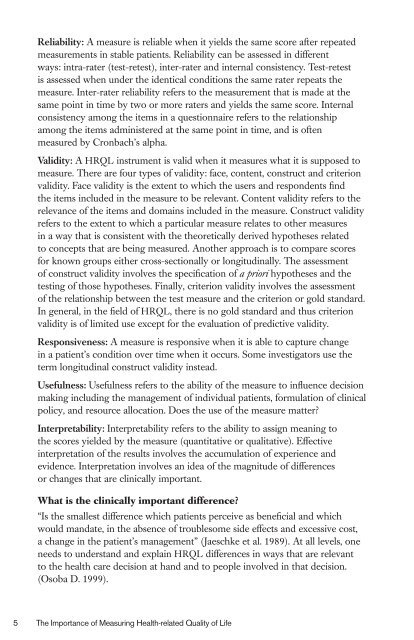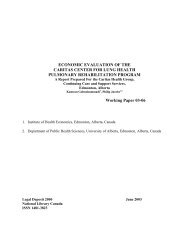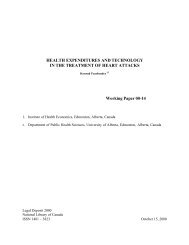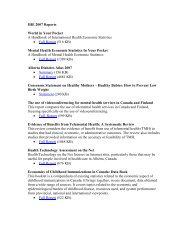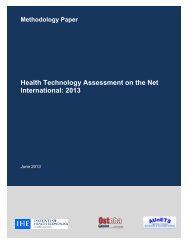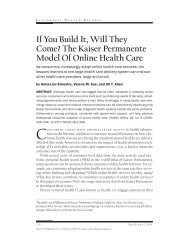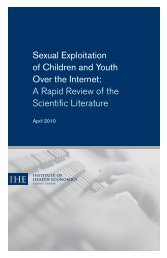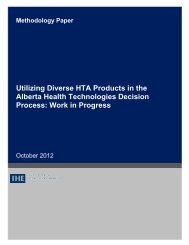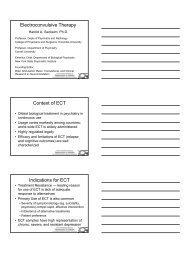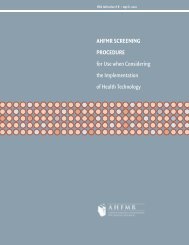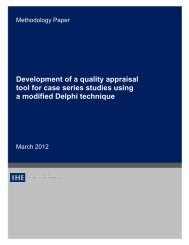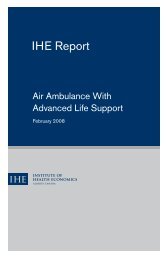IHE Report - Institute of Health Economics
IHE Report - Institute of Health Economics
IHE Report - Institute of Health Economics
- No tags were found...
Create successful ePaper yourself
Turn your PDF publications into a flip-book with our unique Google optimized e-Paper software.
Reliability: A measure is reliable when it yields the same score after repeatedmeasurements in stable patients. Reliability can be assessed in differentways: intra-rater (test-retest), inter-rater and internal consistency. Test-retestis assessed when under the identical conditions the same rater repeats themeasure. Inter-rater reliability refers to the measurement that is made at thesame point in time by two or more raters and yields the same score. Internalconsistency among the items in a questionnaire refers to the relationshipamong the items administered at the same point in time, and is <strong>of</strong>tenmeasured by Cronbach’s alpha.Validity: A HRQL instrument is valid when it measures what it is supposed tomeasure. There are four types <strong>of</strong> validity: face, content, construct and criterionvalidity. Face validity is the extent to which the users and respondents findthe items included in the measure to be relevant. Content validity refers to therelevance <strong>of</strong> the items and domains included in the measure. Construct validityrefers to the extent to which a particular measure relates to other measuresin a way that is consistent with the theoretically derived hypotheses relatedto concepts that are being measured. Another approach is to compare scoresfor known groups either cross-sectionally or longitudinally. The assessment<strong>of</strong> construct validity involves the specification <strong>of</strong> a priori hypotheses and thetesting <strong>of</strong> those hypotheses. Finally, criterion validity involves the assessment<strong>of</strong> the relationship between the test measure and the criterion or gold standard.In general, in the field <strong>of</strong> HRQL, there is no gold standard and thus criterionvalidity is <strong>of</strong> limited use except for the evaluation <strong>of</strong> predictive validity.Responsiveness: A measure is responsive when it is able to capture changein a patient’s condition over time when it occurs. Some investigators use theterm longitudinal construct validity instead.Usefulness: Usefulness refers to the ability <strong>of</strong> the measure to influence decisionmaking including the management <strong>of</strong> individual patients, formulation <strong>of</strong> clinicalpolicy, and resource allocation. Does the use <strong>of</strong> the measure matter?Interpretability: Interpretability refers to the ability to assign meaning tothe scores yielded by the measure (quantitative or qualitative). Effectiveinterpretation <strong>of</strong> the results involves the accumulation <strong>of</strong> experience andevidence. Interpretation involves an idea <strong>of</strong> the magnitude <strong>of</strong> differencesor changes that are clinically important.What is the clinically important difference?“Is the smallest difference which patients perceive as beneficial and whichwould mandate, in the absence <strong>of</strong> troublesome side effects and excessive cost,a change in the patient’s management” (Jaeschke et al. 1989). At all levels, oneneeds to understand and explain HRQL differences in ways that are relevantto the health care decision at hand and to people involved in that decision.(Osoba D. 1999).5The Importance <strong>of</strong> Measuring <strong>Health</strong>-related Quality <strong>of</strong> Life


